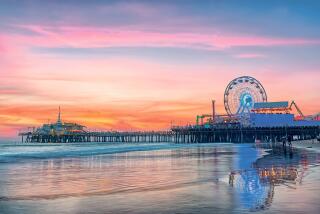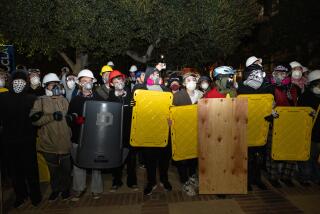After Bay Area violence, California debates classifying ‘antifa’ as a street gang

Experts counter that the idea of classifying antifa as a gang could be seen as punishing a political viewpoint.
Not long after dozens of black-hooded protesters were filmed pummeling people on his city’s streets, Berkeley Mayor Jesse Arreguin made clear his disgust for the self-stylized vigilantes.
“Antifa,” he said, is no different than a street gang, and police should start treating protesters in the anti-fascist movement accordingly.
Later that day, legislators in Sacramento advanced resolutions that would treat violent acts committed by antifa movement’s enemies — white nationalists and neo-Nazis — as terrorist acts under state law.
As forces on the extremes of the nation’s ever-widening political divide continue to battle with fists and weapons on the streets of California, law enforcement officials and politicians have started debating whether these extremist groups should be classified as street gangs.
Such a designation could give law enforcement new tools to combat the groups. Numerous laws on the books give authorities the power to restrict the movements of gang members and enhance criminal charges against them.
But such a move raises legal issues because unlike with traditional street gangs, the underlying motive of these extremist groups is political expression rather than criminal enterprise.
Law enforcement experts say the groups that have been warring in the Bay Area for months — which include anti-fascists and those using “black bloc” militant tactics, far-right organizations such as the Proud Boys and the Fraternal Order of Alt-Knights, and white nationalist groups such as Identity Evropa — certainly share similarities with a street gang.
“It is gang behavior with some ideology. But it is also a social entity as well as a political one,” said Brian Levin, director of Cal State San Bernardino Center for the Study of Hate and Extremism.
Arreguin, the mayor, said he believes that groups on both the left and the right meet this definition. But “it’s something I would want to discuss with our enforcement partners before I make that announcement,” he said.
“There are violent extremists on both sides, and we need to look at a variety of legal and law enforcement strategies to deal with these groups,” he said. “There are organized groups — violent extremists groups — on the left and right that have encouraged people to come to Berkeley and physically confront the antifa or to confront the alt-right.”
But some gang experts also expressed concern about linking the far left to street gang activity. While the groups may share commonalities with gangs, the idea of labeling them as such could be seen as a punishing a political viewpoint, no matter how extreme.
“There’s an argument for it, but there’s also a very grave concern because they are exercising their constitutional rights,” said San Bernardino County Deputy Dist. Atty. Britt Imes, a nationally renowned expert on gang activity. “Their criminal actions, not their free speech actions, their criminal actions, will determine whether they qualify as a criminal street gang.”
Labeling either far-left or far-right groups as street gangs could have serious consequences for those arrested during the inevitable next clash at a counter-protest in California. Under the state’s Street Terrorism Enforcement and Prevention Act — a piece of legislation passed at the height of the nation’s gang boom — gang enhancements can add two to 15 years to a criminal sentence for people convicted of committing a crime in concert with gang activity.
Identified gang members can also be subject to injunctions, or civil restraining orders, that would prevent them from being in certain areas or congregating with friends and even family. Such tactics have been hailed as successes, and decried as draconian by civil liberties groups, in Los Angeles.
A spokeswoman for the Berkeley Police Department said she did not know whether antifa would qualify as a gang under California law.
Any law enforcement agency trying to label antifa protesters as gang members might also run into another problem: Technically, they don’t exist.
Joanna Mendelson, a senior investigative researcher for the Anti-Defamation League’s Center on Extremism, said “antifa” generally describes a way of thinking, rather than a group.
“The antifa is a loose network of individuals who believe in active, aggressive opposition to far-right movements,” she said. “There’s not a clear organizational structure. It’s a movement.”
Antifa does not have a membership, nor does anyone have to claim to be part of the group to embrace its tactics or approach to protests, she added. But some far-left groups that espouse violence have taken on this banner.
Some law enforcement officials believe those groups fit the description of a street gang, even if identifying their followers would be next to impossible.
“I think under state law they could easily be declared a gang,” said Wes McBride, president of the California Gang Investigators’ Assn. “They behave like a gang. They have defined commitment to violence. They have their own gang dress.”
They behave like a gang. They have defined commitment to violence. They have their own gang dress.
— Wes McBride, president of the California Gang Investigators’ Assn.
Imes, who said that he was speaking as an expert and that his comments did not reflect the opinions of the San Bernardino County district attorney’s office, added that many black and Hispanic factions defined as gangs under the law also lack structure or formal membership.
Antifa’s stated goal may be to defeat white supremacists and neo-Nazis, but if the means by which its followers achieve that mission are violent, they could still be defined as a gang, he said.
“The question is going to become have they engaged in a pattern of criminal activity … and is that part of their primary purpose for existing? When you talk about a group engaging in civil disobedience, I am very hesitant to label them a street gang,” Imes said. “However, if their purpose is to come together to cause havoc, or engage in violence, and this is antifa or the white supremacist side … they’re going to engage in conduct that will eventually fit the definition of what a criminal street gang is.”
Those standing across Bay Area battle lines from anti-fascists, including the Proud Boys and the Fraternal Order of Alt-Knights, seem to have more in common with what the average citizen associates with gang lore. The Proud Boys, a national collective of “western chauvinists” founded by former Vice media executive Gavin McInnes, has a formalized initiation process that includes being beaten by members, according to the Southern Poverty Law Center.
Members have to declare themselves as Proud Boys, follow a dress code that includes polo shirts and engage in violent brawls with anti-fascists as part of their initiation, the SPLC has said. The group has regional chapters, including in the Bay Area and Orange County, and some members refer to themselves as “commanders” of specific sets. After an April rally, the Bay Area Proud Boys claimed Berkeley as its “territory,” according to a tweet pinned atop its social media page.
“When they do things like that, and they put things in writing like bylaws … it makes our job a lot easier,” Imes said. “It makes proving the associational organization much easier. When you talk about whether something is a criminal street gang or not, you look to what evidence you have.”
Factions on both sides of the political divide also commit a pattern of crimes that are described in the Street Terrorism Enforcement and Prevention Act, experts say. The repeat brawls in the Bay Area and elsewhere could constitute a pattern of assault. Arson is also listed under the law, Imes said, pointing to fires believed to have been set by anti-fascists during protests in Berkeley earlier this year.
Still, most experts agree that it’s easier to label a group a gang when its criminal acts are divorced from political speech. The Golden State Skinheads are a white supremacy group, for example, but its members have also been known to engage in robberies and drug trafficking.
McBride said he’s less concerned with labels than he is with stopping the endless series of brawls in the Bay Area before they escalate into something worse.
“These young men see it as an adventure with the excitement of a fight,” he said, warning that sooner or later “someone is going to pull a gun.”
Follow @JamesQueallyLAT @boreskes & @LACrimes for breaking news in California.
ALSO
Where the border fence meets the sea, a strange beach scene contrasting the U.S. and Mexico
Along with the migrating steelhead, Oregon river pool holds life lessons
More to Read
Sign up for Essential California
The most important California stories and recommendations in your inbox every morning.
You may occasionally receive promotional content from the Los Angeles Times.













